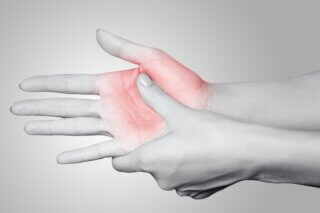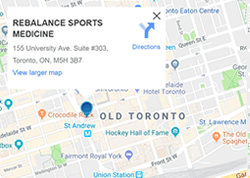Skiers Thumb: Causes, Symptoms, Treatment and Exercises
 Skiers thumb is a term used to describe an injury that often happens to skiers during a fall, which results in an injury to the ulnar collateral ligament (UCL) of the thumb metacarpophalangeal joint.1
Skiers thumb is a term used to describe an injury that often happens to skiers during a fall, which results in an injury to the ulnar collateral ligament (UCL) of the thumb metacarpophalangeal joint.1
Pain is usually localized at the base of the thumb along the web space between the first (thumb) and second (index) finger. Swelling may accompany the injury especially in cases where a fracture is present. Since the UCL ligament provides passive stability to the thumb during pinching and gripping activities, people affected by this injury may report additional weakness with gripping activities, which can often limit participation in day-to-day activities, work, and sports.2
Injuries to the UCL can range from a partial or full tear of the ligament (ie. sprained ligament) to distal avulsion fracture of the UCL at the base of the thumb proximal phalanx or metacarpal head. Some research articles suggest that in some instances, an associated Sterner lesion may occur, which describes the displacement of the avulsed UCL outside of the adductor aponeurosis. If this occurs, surgery is often indicated to reattach the avulsed fragment.1
Causes of Skiers Thumb Condition?
The UCL at the base of the thumb is 12-14 mm in length and 4-8 mm in width.3 There are two portions to the ligament: the accessory UCL and the proper UCL. The accessory UCL is taut in full thumb extension, while the proper UCL is taut in 30 degrees of thumb Metacarpophalangeal (MCP) flexion. Given these properties, the accessory UCL is often disrupted through a valgus (or radial) hyperabduction force when the thumb is in full extension, while the proper UCL is often disrupted through a valgus (or radial) hyperabduction force when the thumb is in 30 degrees of MCP flexion.2 Situations in which this may occur include falls during skiing, goalkeeping in soccer, when a ball or racket strikes the ulnar aspect of the thumb.
How can Physiotherapy, Chiropractic and/or Massage Therapy Help with Skiers Thumb?
The key to treating thumb UCL sprains is to assess it properly. The presence of a fracture or sterner lesion requires immediate consultation with a medical doctor to determine whether surgery is indicated. If your Physiotherapist, Chiropractor, or massage therapist suspects that you have a fracture or sterner lesion, the recommendation to obtain further images should be made. Upon obtaining an X-ray and ruling out a fracture and sterner lesion, your therapist will conduct a physical stress test at the MCP joint in both extension and 30 degrees of MCP flexion to assess the level of laxity in the thumb. If a fracture or sterner lesion is present, your practitioner should be cautious with the stress test and determine whether it is necessary or indicated to assess the stability of the joint initially.
Depending on the severity of your injury, you may be immobilized in a splint or cast for 4 to 6 weeks. By 6 to 8 weeks of your injury, mobilization and strengthening exercises should be underway. Your therapist will be able to guide you through what exercises you should do, how to protect your thumb so that you can engage in your day to day activities, and when it is safe to return to sport.
Treatment of UCL thumb sprains can include manual therapy, soft tissue work, exercises, acupuncture/dry needling, taping, or splinting.
What Should be Avoided with Skiers Thumb Injury?
Avoid radially directed hyper-abduction forces in your day-to-day tasks. Avoid participating in sports without first consulting with your licensed practitioner who can provide clear guidance on the specific tasks and interests that you would like to participate in. Repetitive pinching and gripping tasks can also irritate your thumb, so limiting your participation in activities such as writing and typing may be indicated. If you must do these tasks, your therapist may be able to guide you on how to perform these tasks with greater safety and reduce the likelihood of re-injury.
How Long Does it Take to Recover from Skiers Thumb?
Generally speaking, it takes 8-12 weeks for the ligament and/or associated fractures to heal. With that said, it is not uncommon for rehabilitation to extend to 3-6 months for functional rehabilitation if your physical demands require higher functioning (i.e. playing hockey, working in construction etc.).
What are Safe Home Exercises for Skiers thumb?
 If a fracture or sterner lesion is ruled out, some safe home exercises that you can do include the following fists. Ice can also be applied to your hand to reduce the formation of swelling. Please listen to your body however, if performing any of these activities makes your pain worse, please stop immediately and consult with your certified health care practitioner first.
If a fracture or sterner lesion is ruled out, some safe home exercises that you can do include the following fists. Ice can also be applied to your hand to reduce the formation of swelling. Please listen to your body however, if performing any of these activities makes your pain worse, please stop immediately and consult with your certified health care practitioner first.
References:
- Sen S, Badge R, Murali R. Ligament injuries of the hand. Orthopaedic and Trauma. 2018; 33(1):38-44.
- Avery DM, Inkellis ER, Carlson MG. Thumb collateral ligament injuries in the athlete. Curr Rev Musculoskelet Med. 2017;10:28-37.
- Frank WE, Dobyns J. Surgical pathology of collateral ligamentous injuries of the thumb. Clin Orthop Relat Res. 1972;83:102-114.
Rebalance Toronto
Rebalance Sports Medicine is a multidisciplinary clinic in downtown Toronto offering physiotherapy, chiropractic, registered massage therapy, sports medicine, naturopathy, Pilates and more.



 What to Expect From Your First Physiotherapy Visit
What to Expect From Your First Physiotherapy Visit The Benefits of Fascial Stretch Therapy [Demo]
The Benefits of Fascial Stretch Therapy [Demo] How Does Physiotherapy Work?
How Does Physiotherapy Work? Best Exercises for Low Back Pain
Best Exercises for Low Back Pain